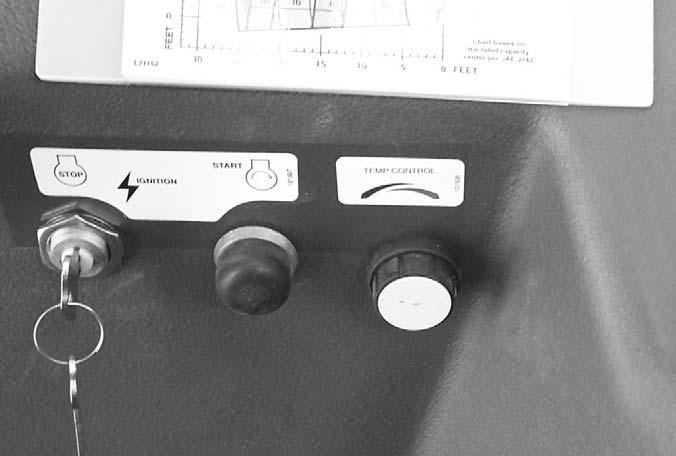
20 minute read
DASH AND STEERING CONSOLE
from GEHL DL SERIES DL7 DL9 DL11 DL12 Telescopic Handlers Operator’s Manual(50960019D) - PDF DOWNLOAD
Instrumentation and Indicator Lamps
Key Switch, Start Button, Temperature Control and Load Zone Charts
A1 - Keyswitch OFF: When the key is vertical in the keyswitch, power from the battery is disconnected to the control and instrument panel electrical circuits. This is the only position in which the key can be inserted or removed.
A2 - Keyswitch ON: When the key is turned one position clockwise from the vertical (OFF) position, power from the battery is supplied to the engine and all control and instrument panel electrical circuits.All indicator lamps in the intrument panel, exhaust filter gauge and switch and the engine emergency override switch will illuminate momentarily as a lamp check.
B - Start Pushbutton: With keyswitch in the ON position, press the start button to activate the starter. Release it as soon as the engine starts.
NOTE: If the engine requires repeated attempts to start, the key MUST be returned to the OFF position between starting attempts to prevent battery run down.
C - Temperature Control Knob: This knob is used to adjust the temperature inside the cab when the heater or air conditioner is in use.
D - Load Zone Charts: A series of flip charts show lift height and reach limits relative to the load weight being handled with various attachment tools.
A - Multi-Function Display Screen: This screen displays the following functions:
• fuel level at all times,
• engine coolant temperature,
• engine oil pressure,
• voltmeter
• hourmeter
• 250 hour maintenance reminder
• error fault codes
B - Scroll Button: Pressing this button changes the function displayed in the multi-function display screen
A1 - Fuel Level Gauge: The fuel level is displayed at all times in the lower portion of the display. It indicates the amount of fuel remaining in the fuel tank.
A2 - Engine Coolant Temperature: Press button “B” until “TEMP” is displayed. It indicates the temperature of the engine coolant. Under normal conditions, this should indicate approximately 185°F (85°C).

A3 - Engine Oil Pressure: Press button “B” until “OIL” is displayed. It indicates the engine lubricating oil pressure.
A4 - Voltmeter: Press button “B” until “VOLTS” is displayed. It indicates the voltage output from the alternator.
A5 - Hourmeter: Press button “B” until “HRS” is displayed. It indicates the total operating time of the machine and should be used for keeping the maintenance log.
A6 - Maintenance Reminder: After every 250 hours a reminder will display: “ROUTINE MAINTENANCE IS REQUIRED CHECK OPERATOR’S MANUAL.” Perform the required maintenance, and then clear the message by pressing and holding button “B” until the message is cleared.
NOTE: The maintenance reminder message must display at least 3 minutes before it can be cleared by pressing and holding Button “B”.
A7 - Error Fault Code: Error codes and a short error description are displayed in this screen. The error code will clear when the error is corrected.
Indicators Lamps
C - Engine Oil Pressure Lamp: This lamp indicates whether or not there is sufficient engine lubricating oil pressure. During normal operation, with the engine running, this lamp should be off. During starting and when the ignition is on but the engine is not running, this lamp will be on.
IMPORTANT: If this lamp comes on during normal operation with the engine running, STOP the engine immediately. After allowing the oil to drain down for a few minutes, check the engine oil level. Maintain oil level at or near the FULL mark on the dipstick.
D - Coolant Temperature Lamp: This lamp indicates if the temperature of the engine coolant is too high.
IMPORTANT: If this lamp comes on during normal operation with the engine running, STOP the engine as soon as possible and check the engine cooling system.
E - Alternator Lamp: This lamp indicates the condition of the electrical charging system. During normal operation, this lamp should be off. If the charge rate is too high or too low, this lamp will come on.
F - Air Cleaner Restriction Lamp: If this lamp comes on, the air cleaner should be checked for a clogged inlet or filter element.
G - Engine Pre-heat Indicator Lamp: When lighted this lamp indicates that the cold weather starting aid is in use.
H - Transmission Oil Temperature Lamp: This lamp indicates whether the transmission oil is at the proper temperature. During normal operation this lamp should be off.
IMPORTANT: If the temperature lamp comes on during normal operation, a problem may exist in the transmission system. Stop the machine as soon as possible and investigate the cause of the problem!
I - Accumulator Charge Lamp: When the operating pressure is too low, this lamp will come on. A low pressure indication requires recharging the accumulator.
J - Low Fuel Lamp: This lamp indicates a low fuel situation. When it first comes on, there is approximately 2.5 gals. (9.5 L) of fuel remaining. The fuel tank should be filled as soon as possible.
K - Hydraulic Oil Filter Lamp: If this lamp comes on, it indicates that the filter element should be checked for possible replacement.
Exhaust Filter Gauge Indicators and Switch
A - Exhaust Filter Cleaning Switch: This switch controls the function of the exhaust filter. It has 3 positions as follows:
A1Center position: In this position the exhaust filter cleaning procedure is set to the automatic (AUTO) mode. Operating the engine in this center AUTO Mode allows the ECU to perform intelligent exhaust filter cleaning as required.
A2Bottom position: In this position the auto exhaust filter cleaning is disabled.
A3Top position: In this position the operator initiates a manual exhaust filter cleaning operation. This process allows the system to clean the exhaust filter when the operator previously disabled exhaust filter cleaning by pressing the bottom of the switch. The top of the switch will need to be pressed for at least three seconds to activate. The indicator in the switch will illuminate when activated and be off when the exhaust filter cleaning is complete.
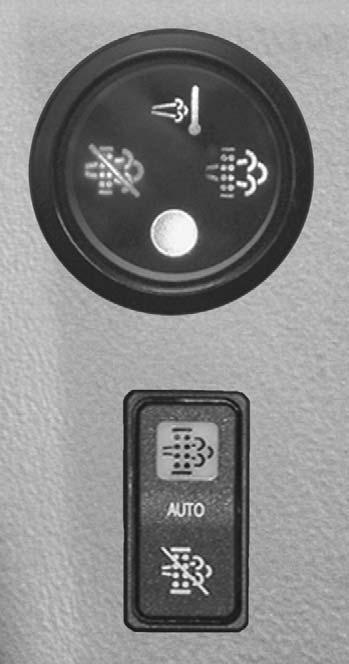
B - Exhaust Filter Gauge: This gauge displays the four indicators you will see through the operator initiated or auto exhaust filter cleaning and disable processes.
NOTE: The indicators in the exhaust filter gauge will all illuminate when the keyswitch is put in the “ON” position for a momentary lamp check. During normal operation all lamps will never all be illuminated at the same time. This image is only to illustrate the indicators you may see during operation.
B1 - Exhaust Filter Cleaning Indicator: This indicator will illuminate when exhaust gas temperature is at optimal regeneration temperature, elevated idle is active, or exhaust filter cleaning is in process.
When this indicator is illuminated, the machine can be operated as normal unless the operator determines the machine is not in a safe location for high exhaust temperatures and disables auto cleaning.
B2 - Auto Cleaning Disabled Indicator: This indicator will illuminate when the operator has disabled the auto exhaust filter cleaning function from the exhaust filter cleaning switch (A). This icon will remain illuminated until the operator reengages automatic exhaust cleaning from the exhaust filter cleaning switch (A). Disabling the auto mode is not recommended for any situation unless elevated exhaust temperatures may be a concern or if the fuel tank lacks the recommended 1/4 tank of fuel to complete the cleaning process.
B3 - Exhaust Filter Indicator: This indicator will illuminate when the exhaust filter is in need of cleaning because the soot level of the exhaust filter is slightly high and the operator has disabled auto exhaust filter cleaning. If conditions are safe, the operator should enable the auto exhaust filter clean setting or perform manual exhaust filter cleaning.
B4 - Exhaust Filter Warning Indicator: This amber or red indicator works in combination with the Exhaust Filter Indicator (B3).
• If this indicator is illuminated amber when the Exhaust Filter Indicator (B3) is illuminated, the engine performance will be reduced by the ECU because the soot level of the exhaust filter is moderately high. If conditions are safe, the operator should enable the auto exhaust filter clean function. If conditions are not safe, the operator should move the machine to a safe location and engage the auto exhaust filter cleaning mode.
• If this indicator is illuminated red when the Exhaust Filter Indicator (B3) is illuminated, the engine performance will be further reduced by the ECU because the soot level of the exhaust filter is extremely high. This combination will lead to a “Service Only” soot condition, contact your authorized Gehl dealer.
Right Bank Switches

Switches have graphic symbols to indicate function and effect. The following mode descriptions start with the first switch on the left.
A - Engine Emergency Override Switch: The lamp in this switch will flash when there is a low oil pressure WARNING or a high coolant temperature WARNING. The lamp in the switch will light continuously at the low oil pressure SHUTDOWN set-point or the high coolant temperature SHUTDOWN set-point.
Pressing and holding the bottom of the engine emergency override switch will override an engine shutdown signal caused by low engine oil pressure or high engine coolant temperature.
This switch must be pressed within 30 seconds to prevent undesired shutdown of engine. The switch can be overridden for 30 seconds at a time to move the machine to a safe location and to lower the boom to the ground. If the engine shuts down, the ignition switch must be turned off and then back on before the engine can be restarted.
NOTE: Holding the switch continuously “ON” will not reset the 30-second timer.
B - Clutch Cutout: When activated, this switch allows faster engine acceleration and power to the hydraulics system without power to the drive axles while the service brake pedal is depressed.
In the OFF position, the clutch mechanism in the transmission remains engaged when applying the brakes. In the ON position, the clutch mechanism is disengaged while applying the brakes.
NOTE: Normal brake force will hold the machine in position while accelerating the engine to power the hydraulic control functions during load placement.
C1 and C2 - Wiper/Washer: The windshield and top window of the operator’s station are each equipped with a wiper and washer mechanism. Switch “C1” operates the wiper and washer on the windshield; switch “C2” operates the wiper and washer on the top window.
D - Fan Speed: This switch increases and decreases circulation of heated or cooled air throughout the operator’s station interior.
E - Heater/AC or Heater: This switch will be either the Heater switch shown or the Heater/AC switch. Pressing the top of the Heater or Heater/AC switch activates the cab heater. Pressing the bottom of the Heater switch turns off the heater. Pressing the bottom of the Heater/AC switch activates the cab air conditioner. Return the Heater/AC switch to the center position to turn the heater and air conditioner off.
F - Parking Brake: When the machine is shut off, this switch should be depressed to activate the park brake mechanism in the front axle.
Left Bank Switches
Left Bank Switches
Switches have graphic symbols to indicate function and effect. The following mode descriptions start with the first switch on the left.

A - Steer Select: Use “2-wheel mode” for higher speed travel. Use “4-wheel mode” for making tighter turns, usually on jobsite. Use “crab mode” when a small amount of side shift is needed for picking or placing loads.
NOTE: The rear wheels are not self-centering. Use the axle alignment switch to determine when the rear wheels are tracking straight. To obtain the proper steer function selected and better machine tracking, make sure all wheels are in a straightahead position before changing the steer mode.
Any of the steering position modes can be used in forward or reverse travel. The operator should learn to anticipate changes in machine movement if the steering selector mode is changed.
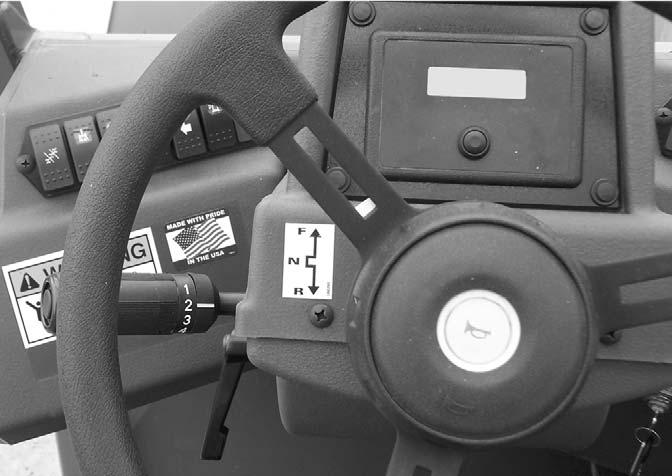
B - Axle Align: Allows the operator to check for straight tracking of the rear wheels. When activated, a green lamp lights on the switch to indicate straight tracking.
C- Head Lights/Work Lights: Pressing the top of the switch will illuminate the lights mounted on the top of the operator’s station and the red tail lights, for use in forward travel operations. Pressing the bottom of the switch will illuminate the lights at the end of the boom in addition to the lights on the operator’s station, for additional lighting in working operations.
D - Hazard: This switch can be activated to make the tail lights flash on and off if the machine is stalled or temporarily stopped in a traffic area on the road or jobsite.
E - Turn Signal Option: This switch is used to indicate the direction of a turn. Depress the right arrow for right turn; depress the left arrow for a left turn.
F - Beacon: When a beacon is installed on the machine, activating this switch will produce a strobelight on and off flashing, for working in conditions that may obscure view of the machine.
G - Personnel Work Platform: This switch is used to activate the Personnel Work Platform (PWP) Safety System. It is a red switch located in the farthest right slot of the left side switch bank. When activated, an amber lamp lights on the switch.
NOTE: This lamp will flash on and off, indicating that the (PWP) system is not fully functional, until the brakes are held on for three or more seconds.
Adjustable Steering Console
A - Position Adjust: This console can be adjusted so the steering wheel is placed in a comfortable operating position. Loosen the quick release handle on the left side of the console and re-position the steering wheel. Tighten the quick release handle to lock in place.
B - Steering: The power steering motor is designed to give low-effort steering with no shock reaction from the axle wheels to the steering wheel. Turn the steering wheel to the right or left to turn the machine in the direction of wheel turn action.
C - Horn Button: With the keyswitch on, press the center of the steering wheel to activate the horn.
D - Travel Lever: Located on the left side of the console, this lever is used to change travel direction (forward or reverse) and the speed of travel around the jobsite or on a road.
Travel Direction: The selector MUST be in “N” (NEUTRAL) position before the engine can be started.
Position “F” (FORWARD)
Position “N” (NEUTRAL)
Position “R” (REVERSE)
NOTE: Backup alarm automatically sounds with travel lever in Reverse.
IMPORTANT: Care should be taken when downshifting or reversing, because damage to the transmission can occur if shifting is forced or attempted at too high a speed. Allow engine speed to slow before down shifting or changing direction.
D - Speed Range: Twist counter-clockwise or clockwise to change the transmission speed between low and travel range.
Position “4” TRAVEL RANGE
Position “3” UPPER RANGE
Position “2” MEDIUM RANGE
Position “1” LOW RANGE
RIGHT SIDE PANEL
These controls and indicators are used to position the frame, boom, and attachment. Graphic symbols on the side panel illustrate the control actions.
A - Frame Leveling Switch: This switch is located on the right side panel behind the boom control joystick.
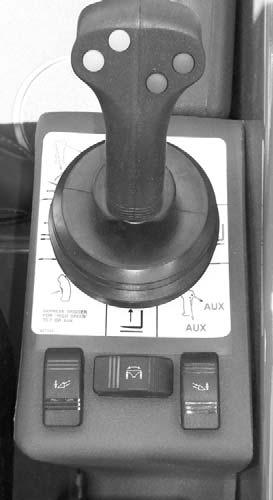
The machine may be tilted slowly 10° to the left or right to level the frame and boom in relation to the ground.
B1 and B2 - Outrigger
Option Switches: This option is used to provide greater stability for specific applications. Press the left “B1” switch forward to lower the left outrigger. Press the right “B2” switch forward to lower the right outrigger. To raise the outriggers, press both switches rearward. Level the frame before lowering the outriggers. Lower the outriggers until the front tires just start to raise.
Warning
DO NOT level the frame with the boom raised or extended. Level the frame ONLY while stopped, with the boom fully retracted and the attachment raised just enough to clear the ground.
Warning
For maximum machine stability, never lower the outriggers so that the tires come completely off the ground.
Do not use outriggers on soft or uneven surfaces. Be sure the surface can support the machine and load.
Be sure NO persons or equipment are located where the outrigger pads will be positioned.
DO NOT travel with the outriggers extended. Adequate clearance is required for the retracted outriggers when traveling through doorways or along narrow pathways.
DO NOT attempt to use the outriggers as a hydraulic jack for maintenance, or to level frame, or for other similar uses.
Failure to heed could result in death or serious injury.
C - Boom Joystick: This machine has a hydraulic-type boom with three or four telescopic sections. The sections extend by means of a hydraulic cylinder and chain system inside the boom, sequenced for uniform extension of each section.
The boom inner section nose has an attachment-carrying device. The Dynattach® attachment bracket is used for framing and masonry attachment tools. The Dynacarrier® attachment bracket is used for special material handling attachment tools.
Both devices are “self-leveling,” meaning that when the operator tilts the attachment to a desired angle, that angle will be maintained as the boom is raised or lowered, extended or retracted, until a new angle is set.
This machine is equipped with one of two types of boom joystick control handles. The following illustrations and instructions detail the operation of each joystick handle type.

Warning
Use extreme caution when raising or extending the boom. The Telescopic Handler MUST be level. Loaded or empty, the machine can tip over if it is not level.
ALWAYS place the transmission in neutral, apply the parking brake and keep the service brake pedal fully depressed before raising or extending the boom.
NEVER exceed the specified lift or reach capacities of the machine. Serious machine damage and personal injury may result. Refer to the load zone charts in the operator’s station or this manual.
If a boom circuit hose should break with the boom up, with or without a load, shut down the machine following the MANDATORY SAFETY SHUTDOWN PROCEDURE page 9. DO NOT attempt repairs. Instead call your Gehl dealer for assistance.
The truss boom and winch attachment tools should ONLY be used to lift and place loads when the machine is in a stationary position. Transporting suspended loads must ALWAYS be done slowly and cautiously, with the boom and load as low as possible. Use taglines to restrict loads from swinging, to avoid overturn.
NEVER use winch for lifting or moving personnel. NEVER exceed the maximum rated capacity of the winch (3000 lbs., 1360 kg) or exceed the load zone chart rating for winch applications.
DO NOT tilt the truss boom back more than 45o from horizontal. DO NOT attempt to use the rotating carriage as a load leveling function. Always level the frame prior to raising a load.
Failure to heed could result in death or serious injury.
Joystick with Two Buttons: This joystick handle is equipped with one yellow button and one blue button on the upper rear of the handle. Pressing the left yellow button activates the attachment tilt function. Pressing the right blue button activates the auxiliary hydraulic function.
To extend the boom, move the joystick right; to retract the boom, move the joystick left. To raise the boom, move the joystick rearward; to lower the boom, move the joystick forward.
To tilt the attachment tool, press and hold the left yellow button, and then move the joystick handle left to tilt the attachment up, or move the joystick handle right to tilt the attachment down.
Two-Button Joystick Function Illustration
To operate the auxiliary attachment hydraulics, press and hold the right blue button on the joystick handle, and then move the joystick handle forward or rearward.
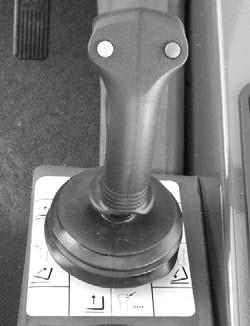
Warning
When tilting the attachment or operating the auxiliary hydraulics with a two button type of joystick handle, to avoid any unexpected action be sure the joystick is at the “neutral” position before pressing the button.
Joystick with Four Buttons: This joystick handle is equipped with two yellow buttons and two blue buttons on the upper rear of the handle, and a trigger switch on the front of the handle. The yellow buttons operate the attachment tilt. The blue buttons operate the auxiliary hydraulics. The trigger switch controls the function speed of both the attachment tilt and auxiliary hydraulics.
To extend the boom, move the joystick right; to retract the boom, move the joystick left. To raise the boom, move the joystick rearward; to lower the boom, move the joystick forward.
To tilt the attachment tool up, press and hold the lower yellow button on the left side of the joystick handle, and pull on the trigger. To tilt the attachment tool down, press and hold the upper yellow button on the left side of the joystick handle while pulling on the trigger on the front side of the joystick handle.
To operate the auxiliary hydraulics, press and hold either the upper or lower blue button on the right side of the joystick handle while pulling on the trigger.
Pulling on the trigger increases the speed of the attachment tilt and auxiliary hydraulic functions.
NOTE: With the four-button joystick, the handle does not need to be moved to operate the tilt or auxiliary hydraulic functions.
Speed Control Knobs: The four-button joystick handle also incorporates a manually-adjusted speed control to allow changing factory-set speeds. This speed adjustment is accomplished through the adjustment of the pilot pressure apply valves located in the rear compartment of the machine.
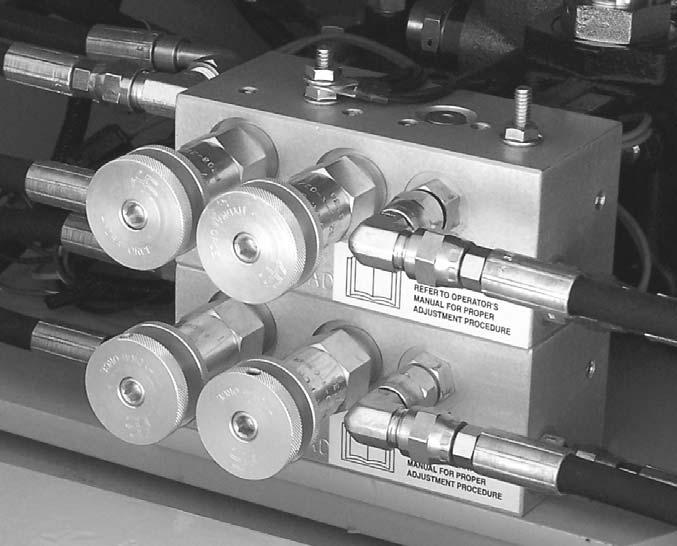

If the machine is equipped with auxiliary hydraulics, there will be two pilot pressure apply valves, each having two speed-control knobs. The upper pilot valve controls the auxiliary hydraulics, and the lower pilot valve controls the attachment tilt function. On the attachment tilt pilot valve, the left knob controls the attachment tilt-back speed, and the right knob controls the attachment tilt-forward speed. On the auxiliary hydraulic pilot valve, the function of the knobs will depend on the type of attachment used with the auxiliary hydraulics. See illustrations below.
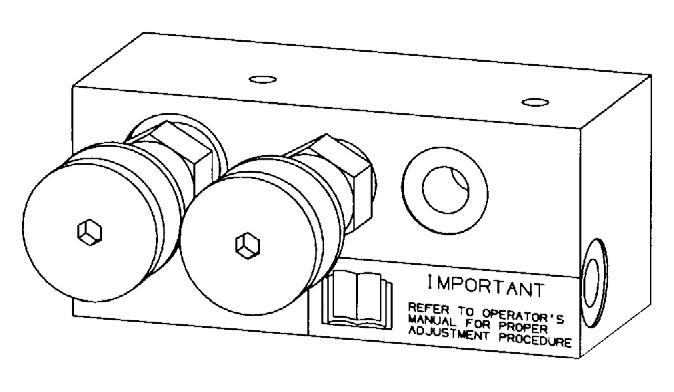
Turning a knob clockwise will increase the speed of its associated function. Turning a knob counter-clockwise will decrease the speed of its associated function.
NOTE: There is a locking knob located behind each adjusting knob, which must be loosened before the adjusting knob can be turned. After adjustment has been made, tighten the locking knob to maintain the selected speed.
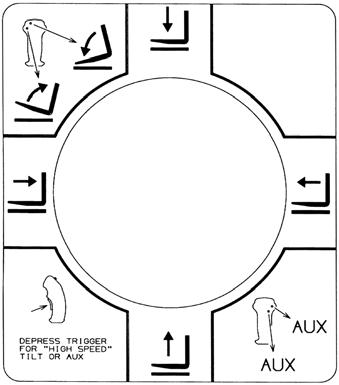
Function Indicators
Frame Angle Indicator: Located in front of the operator on the ROPS upper crossmember. Position of the ball shows when the frame is level relative to a sloping ground surface.
Suspension Seat Option: In addition to the “A” latch handle for forward and rearward adjustment, this seat has a knob “B” under the front of the seat to adjust the suspension. Turn the knob to the right for a softer ride, and to the left for a firmer ride.
Boom Angle Indicator: Mounted on the left side of the outer boom, the position of the ball in the Boom Angle Indicator, shows the angle of the boom relative to the ground surface.
Seat Belt: This machine has a retractable seat belt. Grasp the belt on the left side of the seat pulling the belt over your lap and insert the belt into the buckle on the right side of the seat until you hear it lock in place.
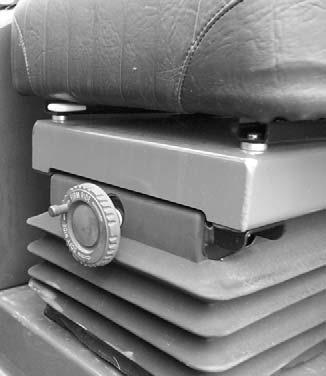
Floor And Seat
Throttle Pedal: This pedal, operated by the right foot, controls the engine speed to match power requirements. Pushing down on the pedal increases the RPM, letting up on the pedal decreases RPM.
Service Brake Pedal: Pressing this pedal activates the internal braking mechanism in both the front and rear axle.
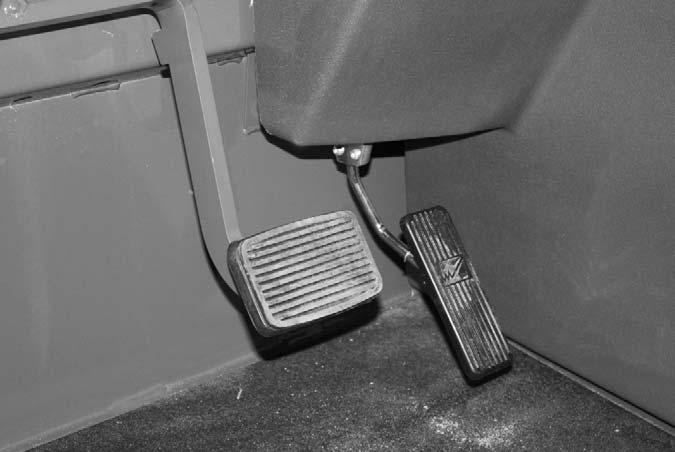
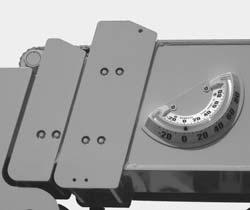
Service And Safety Features
The following indicators are for fluid level and pressure checks.
Hydraulic Test Ports: Two test ports are located under the center cover near the transmission dipstick. Use these ports for installing a test gauge to check hydraulic main and steering relief system pressures and also the joystick relief pressure.


Seat Positioning: The seat is mounted on rails for forward and rearward repositioning, for comfort and to accommodate the operator’s size. A spring-loaded latch handle “A” under the front of the seat actuates the adjustment mechanism.
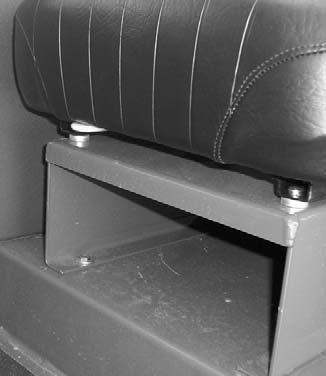
Hydraulic Reservoir Oil Level and Fill Cap: The hydraulic oil level dipstick is located on the rear wall of the power train compartment forward of the hydraulic cooler. The hydraulic oil fill cap is located to the rear of the hydraulic cooler. See illustration below.
Coolant Level: A coolant level sight glass is located on the rear of the radiator. The level should be checked when the engine is cold. Add coolant if it is not visible in the sight glass. Add coolant though the radiator cap until it is visible in the sight glass. See illustration below.
Engine Oil Level: The dipstick is located on the right side of the engine.
Battery Disconnect Switch: The battery can be disconnected from the electrical system by turning the disconnect switch key to the OFF position.
Backup Alarm: Located inside the rear frame cover, the backup alarm produces a loud warning sound whenever the transmission is in reverse.
Side Rear View Mirror: This mirror is located on top of the frame leveling cylinder mount. It provides the operator with a view of the area on the right side and behind the machine.
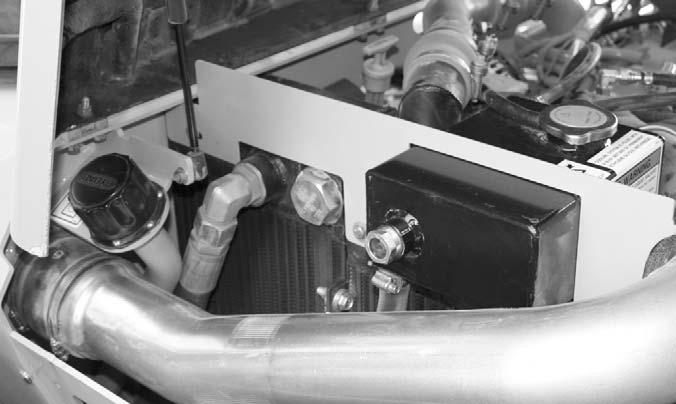
Locking Power Train Covers: To tilt back the midframe access cover and the power train cover, pull out the lock mechanism handle and tilt up. Two gascharged springs help tilt back each cover, and keep them raised.
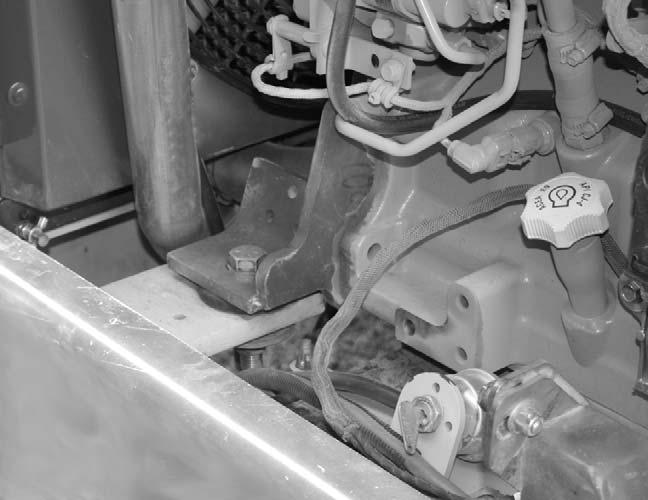
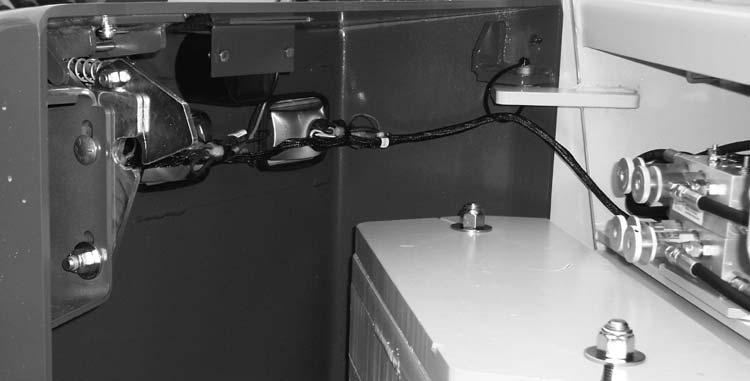
Windshield Washer Reservoir: Located under the engine cover to the front of the engine compartment, the fluid level is visible through the reservoir. Remove the cap to fill with windshield washer fluid.
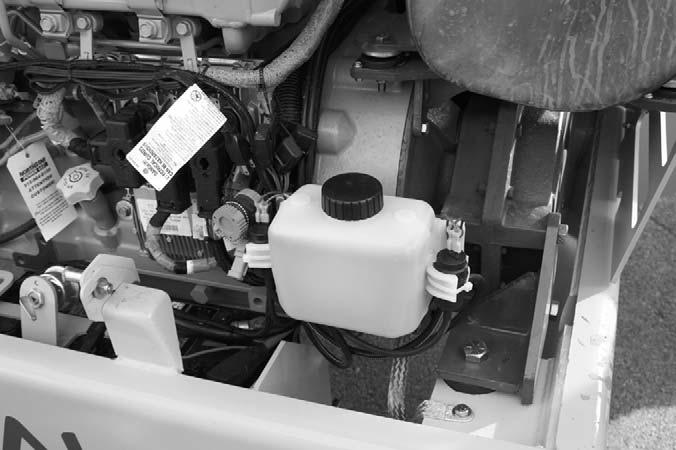
Transmission Oil Level and Fill Cap: The combination dipstick/fill tube is located under the center drive train cover as shown below.

Fuse and Relay Box: This box is located on the front inside wall of the storage compartment behind the operator’s compartment. A decal provides a quick reference guide for troubleshooting electrical functions.
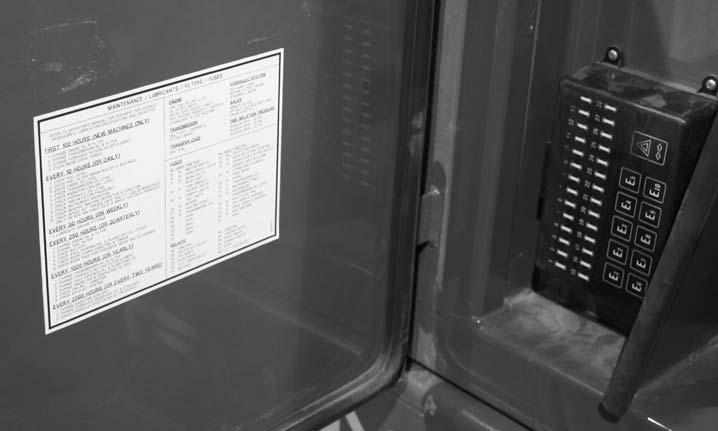
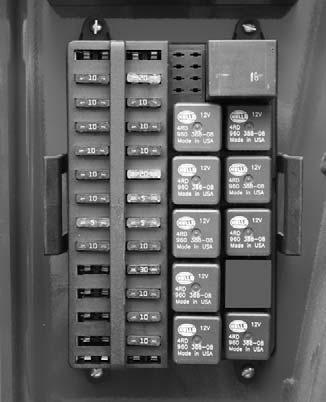

9.10 Amp - Canopy Lights, Tail Lights
10.10 Amp - Turn Signals, Hazard Lights
11.10 Amp - Boom Lights, Rear Lights
12.10 Amp - Horn, Brake Lights
13.10 Amp - Ignition Switch, Preheat
14.Open
15.Open
16.10 Amp - Auxiliary (Ignition)
17.10 Amp - Front Wiper/Washer
18.10 Amp - Top Wiper/Washer
19.30 Amp - Heat and A/C Fan
20.10 Amp - Outriggers, Cold Start Aid, Transmission Declutch
Fuse and Relay Functions: The cover of the fuse box has a diagram indicating the position of the fuses and relays inside the box. Remove the cover to gain access to the fuses and relays. Refer to the illustration and following descriptions for the fuse and relay functions.
21.5 Amp - Instrument Panel
22.5 Amp - Transmission ECU (Standard)
23.20 Amp - Open
24.10 Amp - Stabilizing Cylinder, Park Brake
25.10 Amp - Frame Level, Steer Select, Backup Light and Alarm
26.10 Amp - Gear Selector, Joystick
27.20 Amp - Select Solenoids
28.Open
RELAYS:
E1.Ignition
E2.Tilt/Boom Select
E3.Park Brake and Stabilizing Cylinder
FUSES:
1.Open
2.Open
3.Open
4.Open
5.Open
6.10 Amp - Transmission ECU (APC 120 only)
7.5 Amp - Auxiliary (Battery)
8.10 Amp - Beacon
E4.Top Wiper
E5.Heat-A/C Select
E6.Lift / Auxiliary Hydraulic Select
E7.Open
E8.Canopy Lights
E9.Front Wiper
E10.Fan High Speed
Attachment Tools
Gehl Company offers a range of attachment tools to meet various lifting and material handling applications. Contact your Gehl dealer for specifications and ordering information.
Accessories
Gehl also offers a range of special accessories for this machine. Contact your Gehl dealer for specifications and ordering information.
NOTE: All accessories are field-installed unless otherwise noted. Information and parts for installing accessories are provided by your Gehl Telescopic Handler dealer or Gehl Company.
Chapter 6 OPERATION AND ADJUSTMENTS
General Information
Caution
BEFORE starting the engine and operating the Telescopic Handler, review and comply with ALL safety recommendations in the SAFETY chapter of this manual. Know how to STOP the machine before starting it. Also, BE SURE to fasten and properly adjust the seatbelt.
ENGINE BREAK-IN
A new engine does not require extensive “break-in.” However, for the first 100 hours of operation, follow these guidelines: Operate the engine at various conditions during the initial 100 hours with at least 15% of the time under heavy loads to achieve adequate engine break-in. Check the oil level frequently and replenish as necessary with the oil specified in the engine manual.
John Deere engines use a “break-in” oil for the first 100 hours of operation. After the first 100 hours of operation, change the oil and replace the oil filter.
If the engine has too much operating time at idle, constant speeds, or light load usage, or if make-up oil is required during the first 100 hour period, a longer break-in period may be needed without changing the break-in oil until 500 hours.
During the first 20 hours, avoid prolonged periods of engine idling or sustained maximum load operation. If engine will idle longer that 5 minutes, stop the engine.
Consult the Lubrication chapter for the type and grade of oil to use. Refer to the Service and Storage chapter for the proper service intervals.
PRE-START WALK-AROUND INSPECTION
It is the operator’s responsibility to perform a pre-start inspect of the machine before the start of each workday. Every pre-start inspection must include more than simply checking the fuel and oil levels. It is a good practice to personally inspect any machine you are assigned to use, even though it has already been put into service by other personnel.
The pre-start inspection is designed to discover if the machine has incurred any damage or is in need of routine service.
Any needed repairs are to be made by a qualified service technician.
Refer to the illustration and checklist on the next two pages for the “Pre-Start Walk-Around Inspection.”







